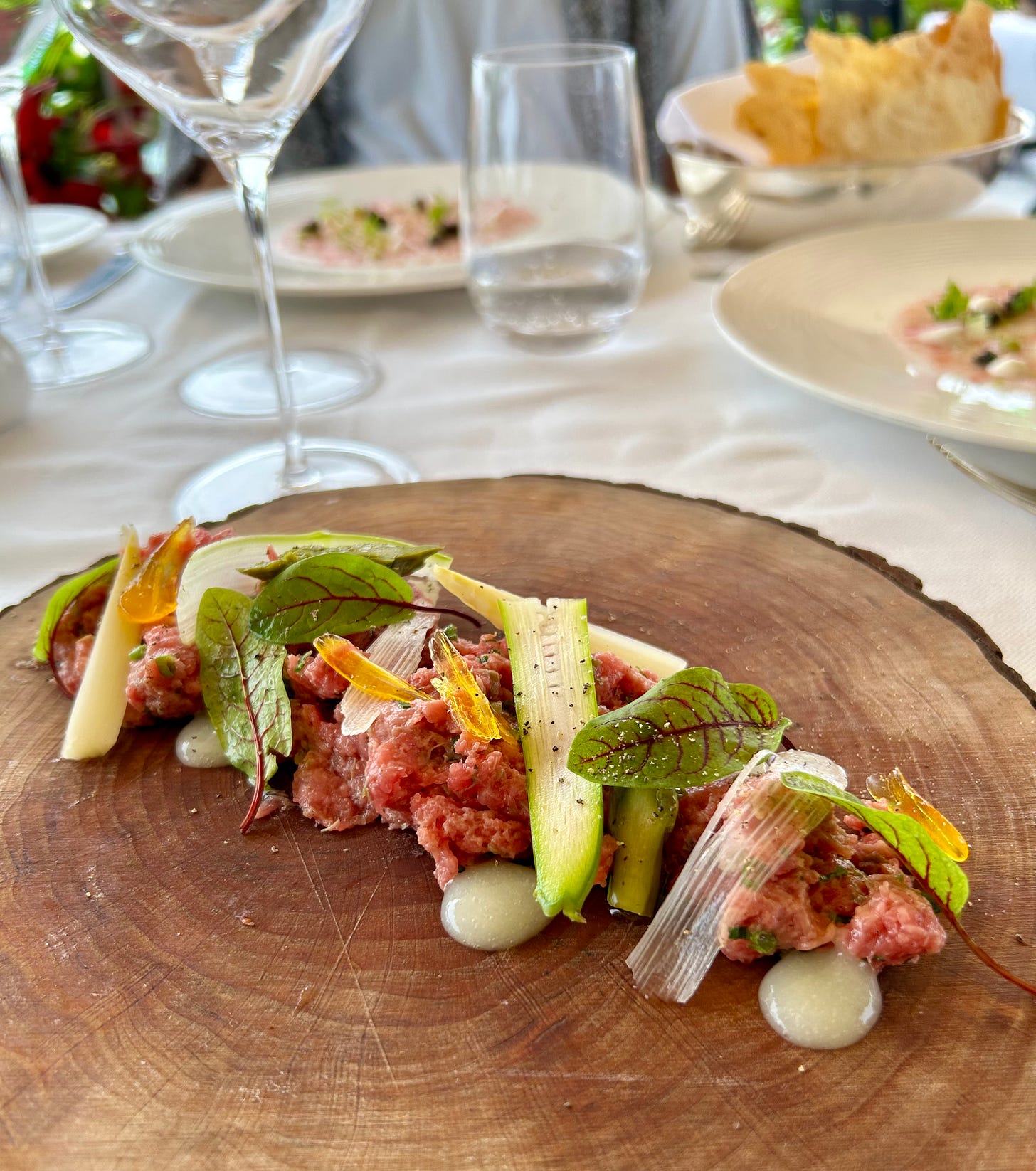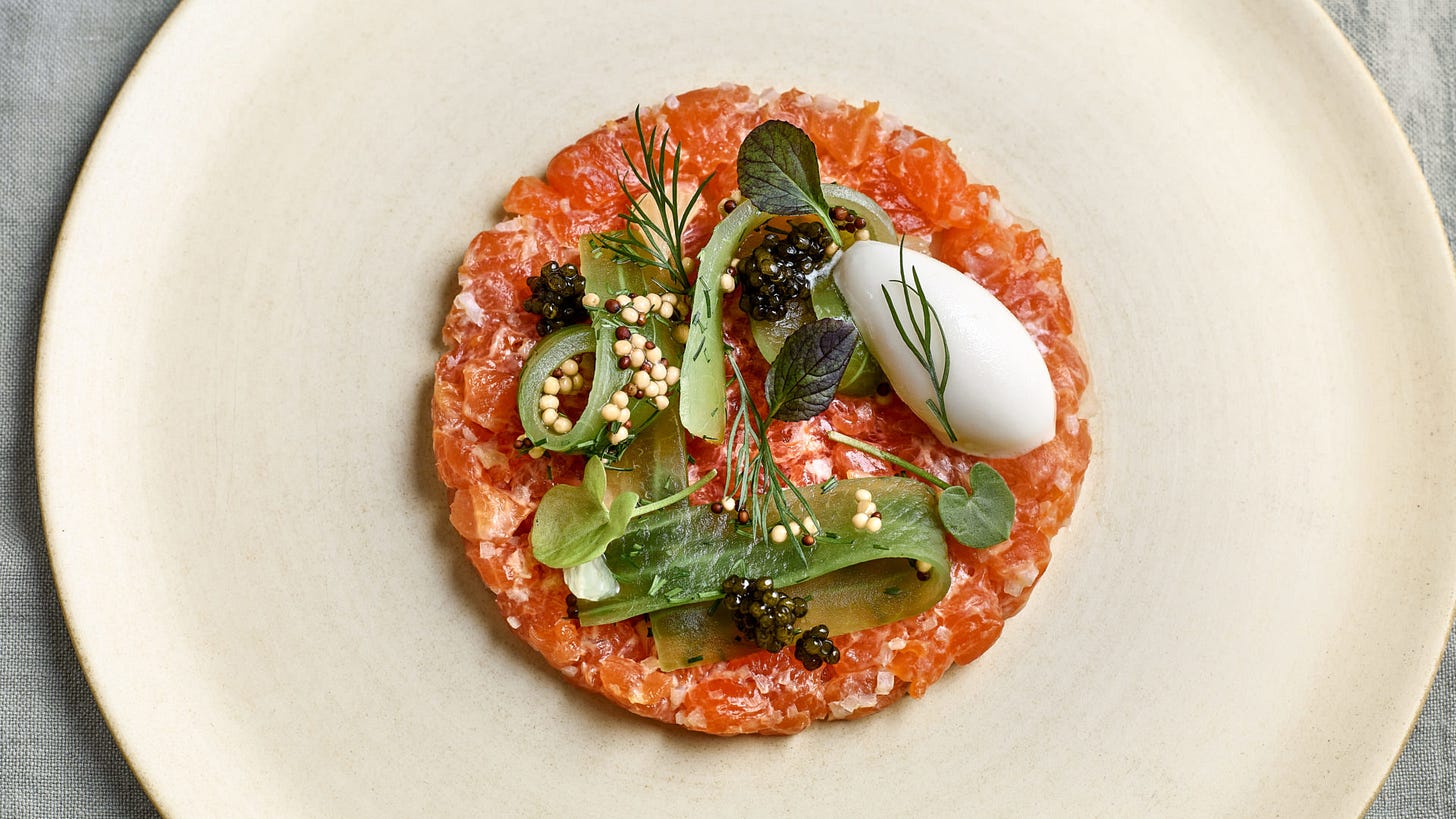While recently travelling in Italy, I was lunching at the exquisite Hotel Danieli’s rooftop restaurant Terrazza Danieli, where I was surprised to see an old favourite listed on the menu: beef tartare. As the weather was sunny and hot, I wasn’t all that hungry, but opted for the tartare because when well made, a tartare gives you a hit of protein without the heaviness of cooked meat. It also pairs beautifully with both red and white wine. So there I was overlooking the Venetian lagoon, enjoying every bite of their a hand-chopped beef tartare with truffle mayonnaise and mixed salad, thinking life doesn’t get much better than this, but also, how it had been ages since I enjoyed a fancy restaurant tartare.
A plate of tartare is a beautiful thing. There's the intense red of the raw meat or the pretty pastel of the cubed raw fish that contrast so perfectly with the bright green herbs like parsley, chives or cilantro. I like the look of the glistening vinaigrette that holds it all together, the cold hit of the mix as it meets the tongue, the tingle of the spice, and the way it slips so easily down the throat after just a few gentle chomps.
In 2008, I wrote about how tartare mania had taken over Montreal restaurant menus. It was so popular that it seemed like every fine-dining dining restaurant or casual bistro offered some form of cubed raw flesh. If you counted diced mangoes, strawberries and kiwi, you'd even find tartare gracing the dessert menu.
The meat version often counts a raw egg to bind it together and Tabasco to give it kick, whereas fish tartares are usually zuzzed up with flying fish roe and salty Asian sauces. You'll find them listed as both an appetizer and main course, and most commonly they are shaped into cylinders, quenelles or patties.
According to the Oxford Companion to Food, the word tartare denotes piquancy, or specifically dishes flavoured with onion. Both the classic steak tartare and the famous sauce tartare do contain onion as well as gherkins, chives, capers and fresh herbs. Other traditional ingredients include mustard and Tabasco - either a drop or a lug if the customer requests his or her tartare "piquant" (spicy).
Garde-Manger chef Chuck Hughes once told me that,"Tartare is like music: There's classical, hip hop, all kinds of styles. And as with pizza, you can do whatever you want with it. I like it as traditional as you can get, or as funky as possible." Hughes makes a mean tuna tartare, and his beef tartare is sometimes mixed with olives, parmesan cubes, celery leaves and jalapeno peppers. Yum!
At the famous Montreal bistro L'Express, the classic steak tartare is such a beloved menu item that they produce close to 200 portions a week, or close to 11,000 annually. In summer it’s so popular that they average 30 orders a day.
Last week, beef tartare popped up again at the restaurant Hamlet & Ghost in Saratoga Springs, New York. Their steak tartare with crème fraîche, sweet onion, and salsa roja was served in a horseshoe shape, fitting for a city famous for its thoroughbred racing track. I relished every bite.
Steak tartare - or, as the Belgians call it, "biftek à l'américaine"is certainly not new. For decades it has been a mainstay at Montreal restaurants and I still recall it being prepared tableside at restos like Le Mas des Oliver and Le Caveau. Purists will argue the dish should be made with horsemeat, but in Montreal you will more likely find it made with beef as well as ostrich, deer or bison. At the former Anise, Chef Racha Bassoul used to make it with duck and lamb, which when mixed with cracked wheat becomes the Lebanese dish kebbeh nayeh.
No doubt fish tartares take their inspiration from the meat dish, yet raw-fish-rich Japanese cuisine surely plays a role. Fish tartares came into being in the early '90s, right about the same time chefs were feasting on spicy tuna maki rolls. The influence of Japanese cuisine as well as a greater variety of fresh fish on the market took tartare from a riff on the classic to a means of expression.
The first time I tasted a fish tartare was in 1995 at the original Toqué!, where chef Normand Laprise's salmon tartare was considered a signature dish. Decorated with taro-root chips, his rendition was a simple mélange of cubed salmon, chives and mustard vinaigrette.
Though considered cutting-edge then, tartare has come a long way and now can be found alongside other popular raw dishes like ceviche, carpaccio, gravlax and the slightly-seared tataki. Home cooks have also caught on to the endless possibilities of tartare. No doubt foodies are inspired when dining out, but the inclusion of tartare recipes in cookbooks by star chefs has unlocked the secrets for making what really is no more complex than a composed salad, popular dinner-party fare.
That said, not all tartares are memorable.
I have a rule that says if after three bites the tartare no longer excites, it gets a failing grade. Because raw meat or fish isn't all that flavourful on its own, supporting condiments are a must. Within reason. Nothing kills a good tartare like an abundance of acrid onion. Then there are those spotted-flesh tartares that are partially "cooked" by an excess of lemon juice.
Unevenly cut chunks of meat or fish point to an amateur behind the cutting board. Greasy tartares are no worse than the dry ones that fall apart, and the most unforgivable tartare sin is meat or fish that's far from fresh - which to be fair, is something I've rarely encountered.
TARTARE TIPS
Here are some tips for making memorable tartares, but first a word of caution: You're dealing with raw meat or fish, so make sure your dish is as safe as it is delicious. There is always a risk of pathogens, so people with compromised immune systems, youngsters and pregnant women should abstain.
Go fresh: Use only the absolute freshest fish and best-quality meat from a reputable source.
Be clean: Cleanliness is next to godliness. Make sure your equipment is impeccably clean. That includes the bowl, the knife and the cutting board. Before making a tartare, wash your hands and get out a brush to scrub your nails clean. Use your newest cutting board and make sure your knife is razor-sharp.
Keep cool: The meat or fish must always be kept very cold until it hits the plate, even between buying it at the store and getting it into your fridge. Keep the bowl in which the mixture is prepared in an ice bath, place your knife in the freezer to chill before slicing, and never let anything sit on the counter for too long. Work in small batches.
Consider texture: For a less mushy texture with fish tartares, cut cubes of fish bigger than usual, about 5 mm (1/4 inch). Try to add at least one crunchy ingredient (such as croutons) for contrasting texture.
Take it easy: Don't drown out the flavour of the central ingredient with too much salt, onion, mustard, vinaigrette or herbs. With fatty fish like salmon or trout, go easy with the olive oil to avoid ending up with a heavy mix. Remember, such fish are already quite oily.
Be careful with the lemon: Add lemon zest to fish tartares instead of lemon juice. The zest has more intense flavour and won't "cook" the flesh. Also, grate your zest directly over the tartare mix to help catch any essential oils.
Do it last-minute: Most restaurants make tartare to order, so follow suit.
In my years as a restaurant reviewer, I tasted my share of both meat and fish tartares. The best were light on the onion and mayonnaise and included something to give it a little punch and crunch. Here are two of my favourite recipes:
Keep reading with a 7-day free trial
Subscribe to Lick my Plate to keep reading this post and get 7 days of free access to the full post archives.






